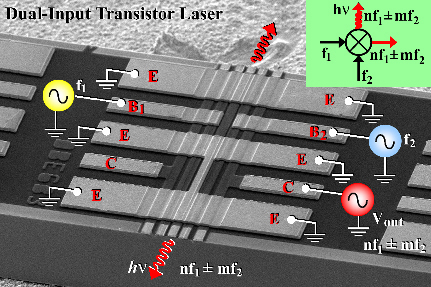
Scanning electron microscope image of a dual-input heterojunction bipolar transistor laser (HBTL) on a Cu heat sink acting as frequency mixer for up and down conversion. The image shows a cleaved, front to back, segment of the laser crystal with emitter (E), base (B), and collector (C) metallization as shown. The laser output is shown schematically as hV and the electrical output as Vout. Both output signals produce integer multiples (mixing) of the input signals at frequencies mf1 +nf2.
By modifying the base region with quantum wells and resonator configurations, Holonyak, electrical and computer engineering professor Milton Feng, and their colleagues have shifted the transistor operation from spontaneous emission to stimulated emission. The altered recombination process of the transistor changes the device characteristics, giving near laser threshold a fundamental and potentially useful non-linearity.
The scientists describe their work in the Feb. 6 issue of the journal Applied Physics Letters.
The transistor laser combines the functionality of both a transistor and a laser by converting electrical input signals into two output signals, one electrical and one optical.
As proof of concept, the researchers demonstrated the operation of a transistor laser as a non-linear microwave mixing device and signal processor using a single emitter and a twin-contact base. Two signals, one at 2.0 GHz and one at 2.1 GHz, were mixed. Both electrical and optical output signals were obtained at mixing frequencies from 0.1 GHz to 8.4 GHz.
The data make it clear that stimulated recombination in a transistor, besides its implications for another form of laser with modulation speed potentially as high as that of a transistor, is the basis for a useful non-linear element, a different form of electronic switch and processor, the researchers said.
The transistor laser also raises the possibility of replacing wiring between components at the chip- or board-level with optical interconnects, thus offering more flexibility and capability in electronic-photonic integrated circuits.
University of Illinois at Urbana-Champaign